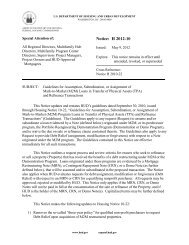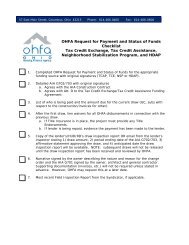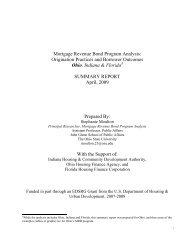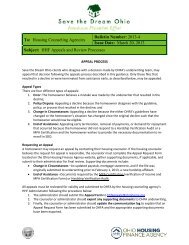lis 217 stemming the tide - LISC
lis 217 stemming the tide - LISC
lis 217 stemming the tide - LISC
- No tags were found...
You also want an ePaper? Increase the reach of your titles
YUMPU automatically turns print PDFs into web optimized ePapers that Google loves.
after refusing to accept <strong>the</strong> housing authority'spayment standard as <strong>the</strong> maximum rent. Thecity negotiated a settlement in which it acquired<strong>the</strong> property with state and local funds.Ownership was eventually transferred to anational nonprofit organization.In Denver, Colorado, after <strong>the</strong> owner of EastVillage Apartments opted out of a 160-unit project-basedSection 8 contract, <strong>the</strong> city and <strong>the</strong>project’s tenants sued to acquire <strong>the</strong> propertyunder eminent domain. A purchase, whichincluded substantial state and local funding,was ultimately negotiated with <strong>the</strong> DenverHousing Authority. Tenants are negotiating fur<strong>the</strong>rwith <strong>the</strong> housing authority to ensure that<strong>the</strong> Section 8 contract is renewed on a longtermbasis.Both Denver and Portland now have ordinancesthat explicitly authorize <strong>the</strong> locality to use eminentdomain to preserve affordable housing.O<strong>the</strong>r Legal ClaimsA variety of o<strong>the</strong>r legal claims have been usedby residents and advocates to challenge conversionsof federally subsidized housing. 33 Forexample, <strong>the</strong> conversion may constitute abreach of existing local use restrictions (seeabove). The owner may have violated federal,state, or local notice requirements. Or <strong>the</strong>remay be a basis for fair-housing claims if <strong>the</strong>conversion will adversely or disproportionatelyaffect members of minority groups, perpetuateracial segregation, or if HUD has failed to promoteo<strong>the</strong>r fair-housing opportunities.Federal PreemptionMany state and local preservation initiativeshave been subject to legal challenge based onfederal preemption claims. Specifically, Section232 of LIHPRHA preempts state and local lawsto <strong>the</strong> extent that <strong>the</strong>y restrict <strong>the</strong> owner's abilityto prepay, are incompatible with LIHPRHA, orare o<strong>the</strong>rwise targeted exclusively to Section236 and Section 221(d)(3) BMIR projects thatare eligible to prepay. At <strong>the</strong> same time, laws of"general applicability," which also include prepayment-eligiblehousing, are not preempted.Accordingly, state and local ordinances shouldbe drafted broadly enough to fall under <strong>the</strong> protectionof <strong>the</strong> general applicability exception.2. FINANCIAL/ TAX INCENTIVESState and local governments have developed anarray of financial and tax incentives to help preserve<strong>the</strong> subsidized housing stock. In designingsuch programs, especially in view of <strong>the</strong>scarcity of state and local funds, a primary considerationis how to target incentives to achieve<strong>the</strong> highest impact. For example:Eligible Property. Should incentives be targetedto properties with <strong>the</strong> highest and mostimmediate risk, or should <strong>the</strong>y be more generallyavailable? Should incentives be limited toproperties at risk of market-rate conversion, orshould <strong>the</strong>y also be available to properties atrisk of disinvestment, default, and foreclosure?Eligible Recipients. Should incentives be availableonly to nonprofit purchasers, or also toexisting owners and/or for-profit purchasers?Broadening <strong>the</strong> scope of potential beneficiariesmay be necessary to garner political support, orto ensure that <strong>the</strong> maximum number of propertiescan be preserved. A possible compromisecould require any existing owner to provide aright of first refusal and/or option to a qualifiednonprofit with respect to any future sale.Long-Term Affordability. What type of userestriction should be imposed? How longshould it last—20, 30, or 50 years? The remaininguseful life of <strong>the</strong> housing?These issues are subject to tradeoffs whicheach jurisdiction will value differently. Finding<strong>the</strong> appropriate balance—for example, whe<strong>the</strong>rto curtail <strong>the</strong> number of eligible recipients andproperties in order to boost long-term affordability—ispart of <strong>the</strong> challenge of developing asuccessful preservation strategy.Preservation Housing ElementIn California, localities are required to prepare a10-year analysis of <strong>the</strong>ir at-risk subsidizedinventories as a component of <strong>the</strong>ir localHousing Element and General Plan. The locality24 chapter three: State and Local Preservation Tools and Strategies
















